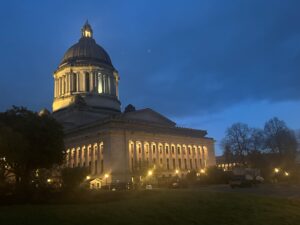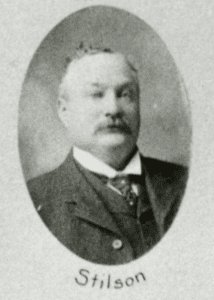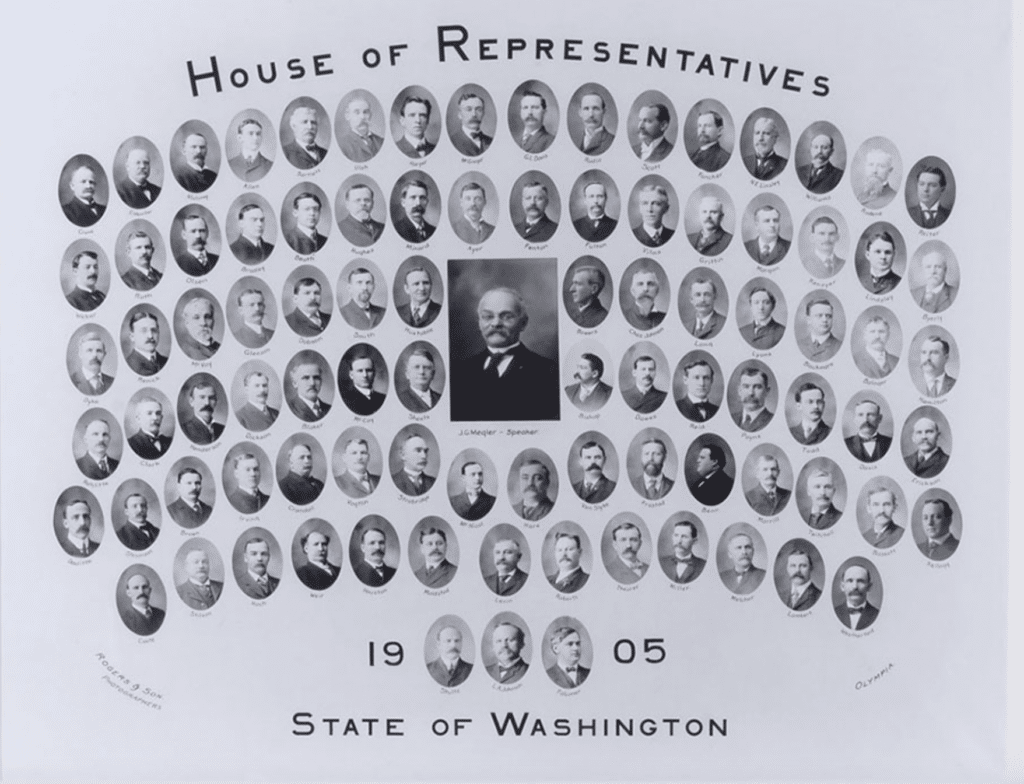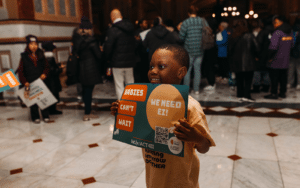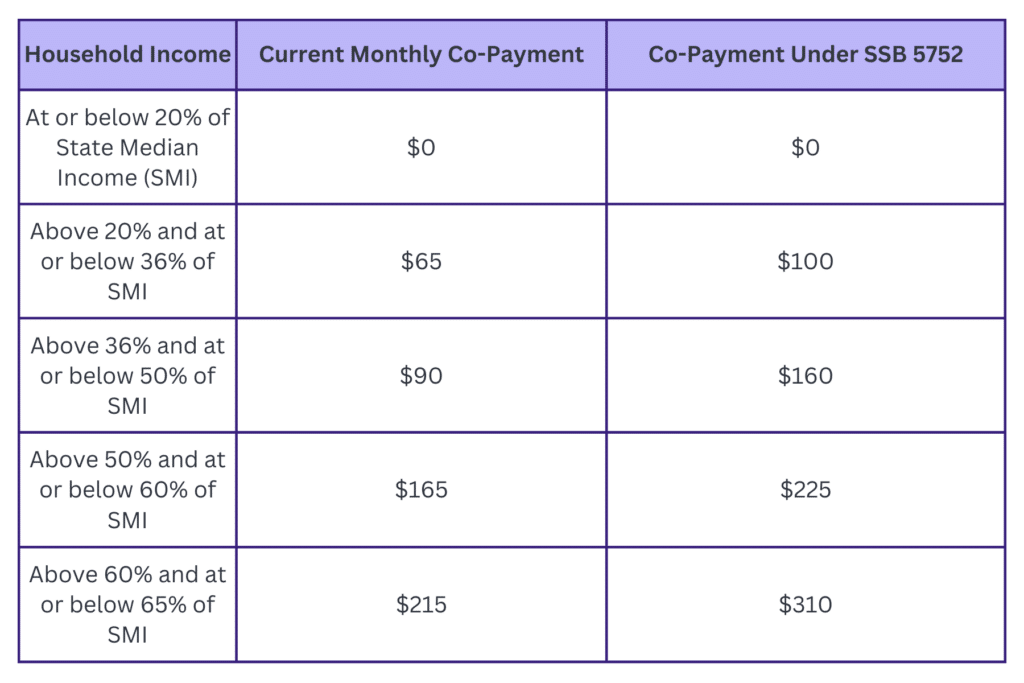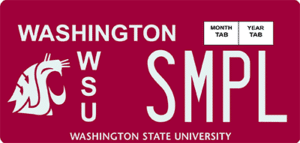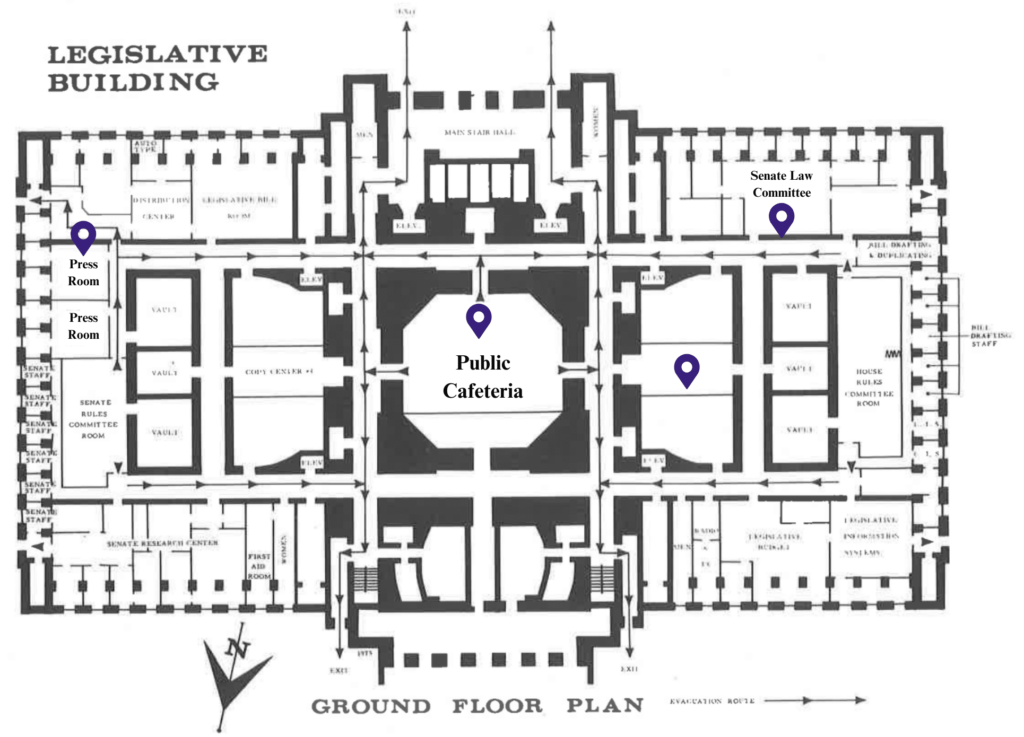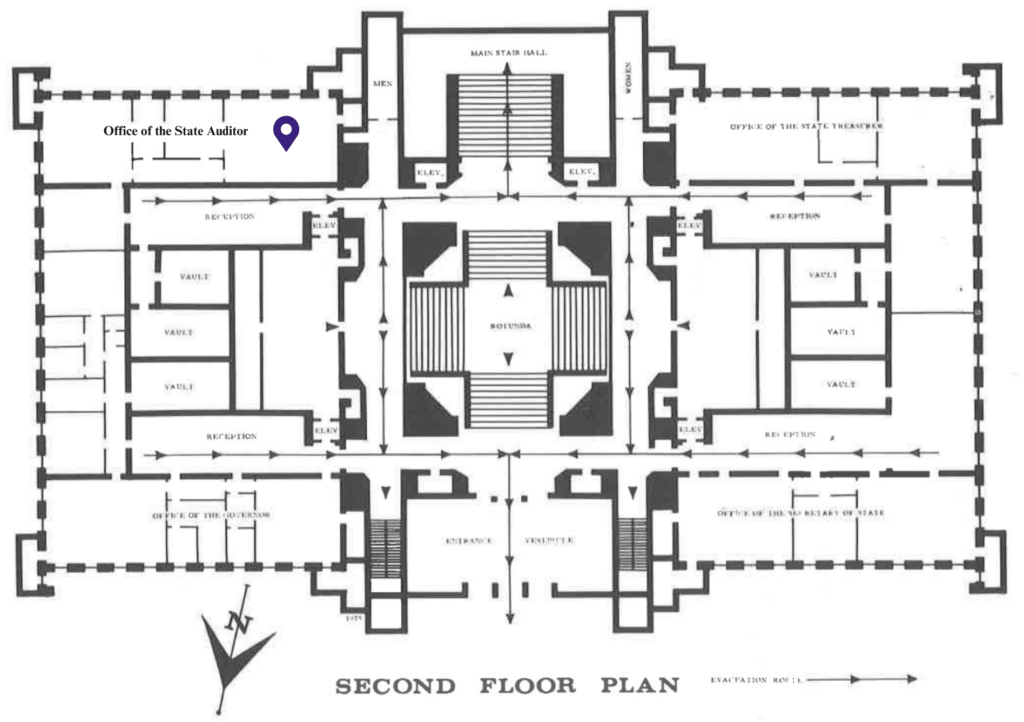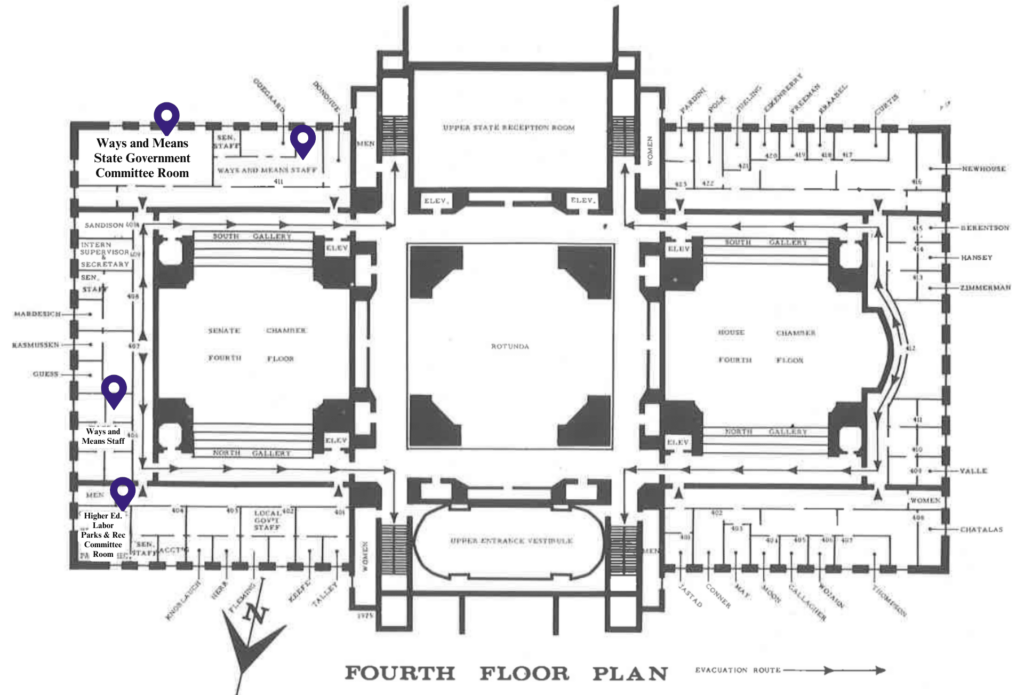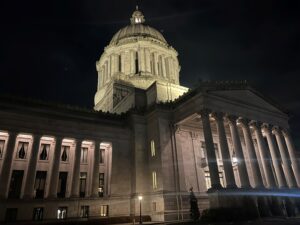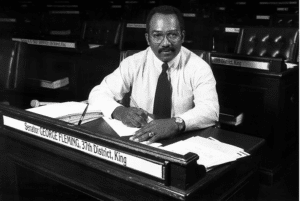
Pre-snowfall on the Capital Campus early Monday morning (y’all see the crane lit up?)
(Photo Courtesy: Erica Hallock)
Trivia!
What was the first building erected on the Capital Campus – the Legislative Building or the Temple of Justice (home to the State Supreme Court and the Administrative Office of the Courts)?
Highlights of the Week
Agency Reduction Exercise Submissions
On February 6, state agency proposed budget reductions were due to the Office of Financial Management (OFM). As noted in last week’s newsletter, state agencies were directed to identify reductions of at least six percent beyond any reductions included in Governor Inslee’s budget proposal.
In addition to suggestions for potential reductions such as pausing legislative reports, the instructions suggest consolidating management positions (10-25% within each agency) and reducing “administrative, executive, and externally focused positions that are not essential to the delivery of government services (10% to 25% within each agency).”
If the cut information is made public, we will include a summary of the details in a future newsletter.
Legislative Leadership Media Availability
I am highlighting the weekly leadership media availability again this week. In particular, I bring your attention to the Democratic leadership media availability and their discussion on the budget (starts around minute 10).
Senate Majority Leader Pedersen highlighted that former Governor Inslee’s publicly released “book 2” budget contained nearly $13 billion in new revenue over the four-year budget outlook, mitigating the need for massive, proposed budget cuts. When responding to a reporter’s question about voter appetite for new taxes, Senator Pedersen pointed to the November election results and compared the three initiatives on the ballot to “three big polls” and said Washington voters support revenue tied to specific services.
Speaker Jinkins spoke to specific cuts that were included in Governor Inslee’s all-cuts “book 1” budget and talked about how these types of dire cuts to programs like Medicaid and developmental disabilities will be on the table if new revenue is not secured. Writer’s Note: Inslee’s “book 1” all-cuts budget was not made public, so the state agency reduction exercise responses will give us a clearer picture of what services and programs are truly at risk in this climate, if they are made public.
In the Republican media availability, Republican leadership continued their messaging that the budget could be balanced with existing resources and without considering new revenue. Republican leadership talked about affordability challenges in a multitude of areas including child care and housing.
Bill Hearings and Action
Workforce Standards Board
On January 31, the Senate Labor and Commerce Committee passed SSB 5062 (Stanford). You will note the title of the bill changed from SB 5062 to SSB 5062. This is because the Committee adopted a substitute bill (meaning it adopted amendments), so the title becomes Substitute Senate Bill 5062, or SSB 5062.
Key changes included in the substitute:
- One of the worker representatives on the board must be from a school-age program.
- One of the employer representatives on the board must represent a small business of 15 or fewer employees.
- The minimum number of board votes for action changed from 5 to 6.
- The standard for board consideration of standards applying to a specific geographic region or specified information when adopting compensation standards changed from “must” to “may”.
- Language was removed specifying that if a standard results in an increase in costs that exceeds federal payments, that standard is not effective until an appropriation is obtained that is sufficient to cover the payment.
- Includes a provision that if an adopted standard results in increased costs for represented Family Child Care providers, the standard is not effective until sufficient funding is appropriated by the Legislature, however the state is not prohibited from providing funding to meet compensation standards.
- Lowers the number of languages required for written training materials from four to three.
SSB 5062 is scheduled to receive a public hearing in the Senate Ways and Means Committee on Monday, February 10. The House companion, HB 1128 (Fosse), is scheduled for Executive Session on February 7 in the House Labor and Workplace Standards Committee.
Cost of Quality Care Rate Model
On Tuesday, February 3, the Senate Early Learning and K-12 Education Committee held a public hearing on SB 5500 (Alvarado) which would modernize the rate-setting tool for child care subsidies in our state. Deemed the “Cost of Quality Care Rate Model,” it was co-created with child care providers, other advocates and the Department of Children, Youth and Families. This new tool is intended to more fully measure and capture the costs of providing quality child care.
In recognition of the state’s fiscal situation, the bill is designed to be cost neutral.
Working Connections Child Care Methodology
The Senate Ways and Means Committee held a public hearing on SB 5310 (Braun) on Monday, February 2. This bill would adjust the payment methodology for Working Connections Child Care to be lesser of the 75th percentile of the Market Rate Survey or a provider’s rate for children not eligible for state subsidy.
SB 5310 has not been scheduled for executive session.
Provider Qualifications
A number of bills addressing child care provider qualifications received public hearings this week. On Tuesday, the Senate Early Learning and K-12 Education Committee heard SB 5279 (Wilson). A note that SB 5279’s House Companion HB 1082 (Eslick) received a hearing in the House Early Learning and Human Services Committee on January 22.
SB 5279/HB 1082 would, among other provisions, direct DCYF to allow child care providers until at least August 1, 2028 to show experience-based competency as an alternative to an Early Childhood Education (ECE) certificate. It would also expand experience-based competency to positions that require an ECE state certificate, including child care center directors, assistant directors and program supervisors.
On Tuesday, February 7, the House Early Learning and Human Services Committee heard HB 1648 (Dent). HB 1648 would extend the timeline for child care providers to complete staff qualification requirements to at least August 1, 2035, or until at least 10 years following the full implementation of all components of the community-based training pathway, whichever is later. It would also allow for a cumulative three years of work experience in licensed child care as a demonstration of experience-based competency to fulfill the staff qualification requirement.
None of these bills have been scheduled for executive session. The deadline for passing bills out of policy committees is February 21.
What’s on Deck for Next Week
Food Days Commence – Starting with Dairy Day!
Longtime readers are familiar with the excitement the various “food association days” bring to those of us who spend our days at the Capital campus. The need to find any morsel of joy (or mouthful of joy!) is amplified this year.
The Washington State Dairy Federation will share numerous dairy offerings on February 11. This writer is crossing her fingers that WSU’s famous Ferdinand’s Ice Cream will be available. I may or may not deploy some of my sixth-grade basketball “box out skills” to secure some of Ferdinand’s magic. Go Cougs!
DCYF Secretary Tana Senn Confirmation Hearing
Before state agency heads receive consideration for confirmation by the full State Senate, the nominee is assigned a Senate Gubernatorial Appointment number (just like a bill). Individuals go before the relevant legislative committee to answer questions about their background, experience and plans for their new endeavor.
On February 11, the Senate Human Services Committee will hold a public hearing on SGA 9222, otherwise known as the Department of Children, Youth and Families Secretary Tana Senn. The following day, the Committee will hold an executive session to advance Senn’s nomination to the full Senate for consideration.
Bill Hearings
Policy Bills Move to Fiscal Committees
- On February 10, the Senate Ways and Means Committee will hear two early learning related bills – SSB 5062 (Stanford) the Child Care Workforce Standards bill, as well as SB 5130 (Wilson) which would eliminate child care licensing fees.
Licensing Bills Receive Hearings
- On February 12, the House Early Learning and Human Services Committee is scheduled to hear two licensing related bills. The first, HB 1033 (Couture), would allow counties to license and regulate child care centers and family child care homes.
- The second, HB 1363 (Caldier), would change the maximum group size and ratios of center staff to children. Specifically, it would provide that preschoolers have a maximum group size of 21 with a ratio of no less than 1:11 (teacher: children), and a school-age maximum group size of 31 with a ratio of no less than 1:16. It would also change current law to specify that licensed indoor early learning program space must have a minimum of 34 square feet per child in attendance. (Currently, preschool group size is 20 with a ratio of 1:10, school-age group size is 30 with a ratio of 1:15, and required program space is 35 square feet per child.)
Leveraging Existing Buildings for Child Care
- On February 12, the Senate Early Learning and K-12 Education Committee will hear SB 5655 (Krishnadasan) – the companion to HB 1582 (Caldier). This bill seeks to make changes to child care licensing requirements so the calculated occupancy load of existing buildings with more than one use (such as churches), would only be based on the space where the child care is provided. The intent of the bill is to leverage existing buildings for child care space.
Bills, Bills, Bills
Governor Ferguson’s Child Care for Small Business/Working Connections Child Care Delay Introduced
HB 1865 (Bergquist) contains Governor Ferguson’s plan to expand eligibility for Working Connections Child Care for families where at least one household member is employed by a small business (defined as 50 or fewer employees) and the household income does not exceed 75 percent of State Median Income at the time of application or, if funds are provided, beginning January 1, 2031, does not exceed 85 percent of State Median Income.
The bill also delays implementation of income eligibility provisions included in the Fair Start for Kids Act. Specifically, it delays the expansion of income eligibility from 60 to 75 percent of State Median Income from July 1, 2025 to July 1, 2029. It also delays the next phase of eligibility expansion from 75 to 85 percent of State Median Income from July 1, 2027 to July 1, 2031, pending the availability of funding.
Increasing Working Connections Access for Graduate and Other Professional Students
Newly appointed House Member Zahn introduced HB 1873 (Zahn) to increase access to Working Connections Child Care for full-time students in graduate and professional education programs at institutions of higher education. The bill sets annual household income at 85 percent of State Median Income for this specific program.
As a reminder, each Thursday, Start Early Washington updates its bill tracker with the latest information on bills we are following. If you would like us to do a deeper dive on a particular bill in a future newsletter, let us know!
